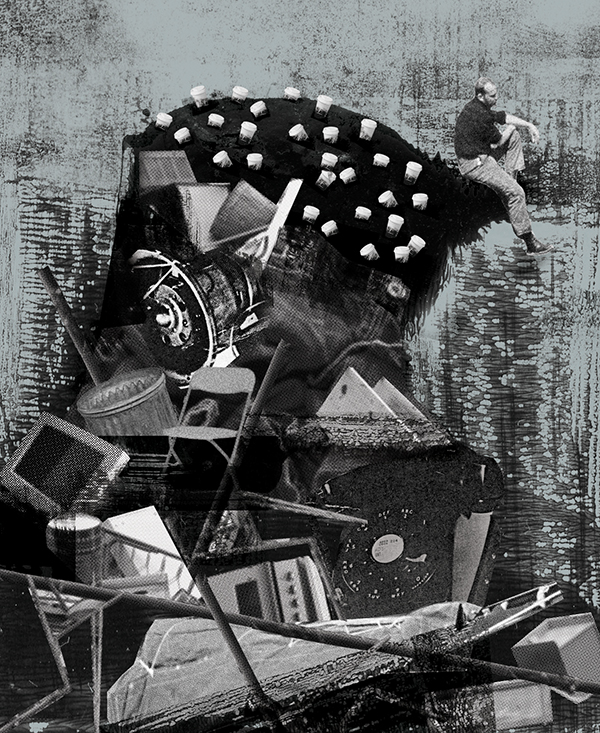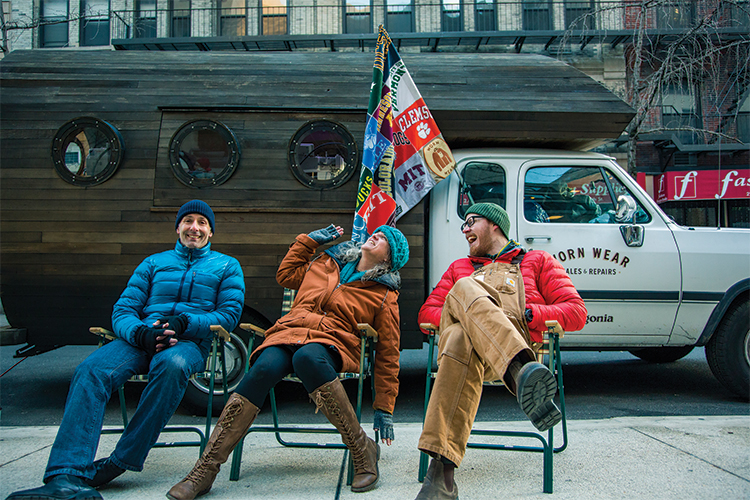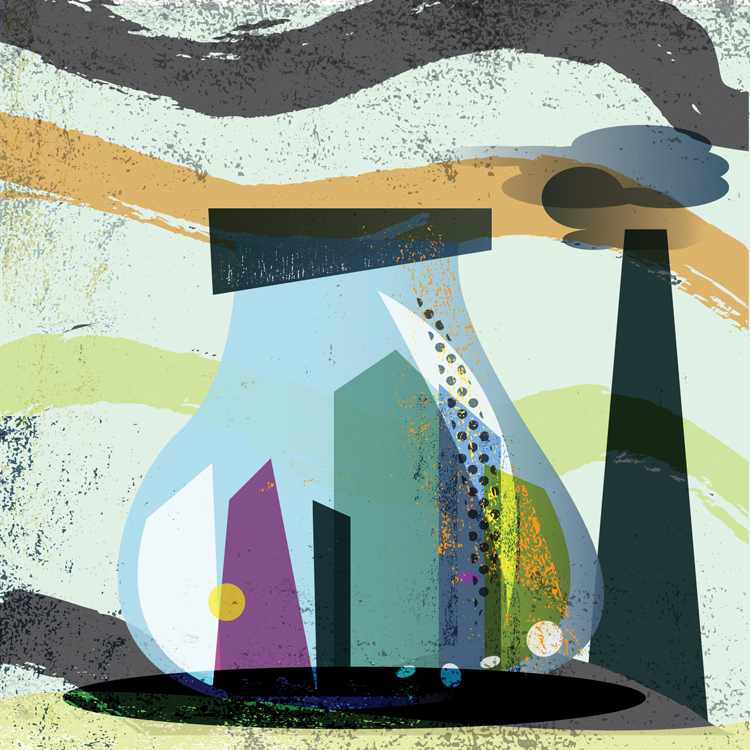Illustration by Kathleen White
Time to Waste
interview by Heather Shayne Blakeslee
Modern products—from store-bought soap to paper plates—are a reflection of the shift from a time when handwork ruled to our age of mass manufacturing. That change in the kind of work we do in our daily lives has also ushered in a time when cleanliness and convenience are the bright face of our culture, behind which we are hiding mountains of waste. Historian Susan Strasser, author of the book “Waste and Want: A Social History of Trash” spoke with Grid about the shift in what we value.
You could say that the idea of waste is subjective: Where one person sees garbage, another sees a raw material.
SS: I think about it not so much as subjective but as culturally determined, and historically determined. … In the 19th century, people wasted astonishingly little. There was an understanding of what it took to make things. Most people, most of what they used, most of what they ate, most of what they sat on, most of what they slept on, most of what they wore, was handmade. A lot of it was handmade by themselves, or people they knew or people that they had a business relationship with. There was an understanding of the labor that was embodied in material goods.
Modern consumers have so little connection to the products they use and consume. We upgrade cell phones, for instance, way before we actually need them, with little thought to the materials extraction or the waste that’s generated. It’s almost the equivalent of kids not knowing that beef comes from cows.
SS: I think it’s very similar, actually. Before the end of the 19th century, people wasted virtually nothing. Clothes, for example. The richest, richest, richest people—the women in an Edith Wharton novel—had their clothes made by Parisian couturiers, and they sent their clothes back to Paris to be remade, to be redone, to get a new collar, to get new buttons, to be brought up to fashion. But they [didn’t] give away their clothes and then buy something new.
You found that there was a big gender component to waste.
SS: I’m particularly interested in those gendered issues of work. It was certainly the case that while women were still at home, working at home—married women for the most part were not out in the workforce—this kind of reuse was part of the work that they did, and part of the way their work saved money for the household.
How did our relationship to waste change as our population shifted from rural areas to densely packed cities?
SS: It’s not just a question of rural to urban. I think it’s a question of people doing handwork to not doing handwork. … An example I really love is, I was once at a friend’s house, and she had a big pile of stuff she was giving away, and as people do sometimes I thought I’d go through it. And there was a sweater that she really loved, and I was surprised to see it there. And I commented, “Why are throwing this away?” and she said, “Well, there’s a hole in it.” And because I know how to knit, I said, “Well, I’ll fix it for you.” People who know how to make things often know how to repair things. …Most Americans don’t any longer have those skills. They don’t know what to do. I mean, it’s coming back in a way—the whole Etsy thing, the whole hipster thing. But it’s coming back as a niche thing. This isn’t the way the whole culture rolls. The culture rolls at H&M.
I was interested to see that some of the first companies to mass market household products, like soap, include really big companies like Procter & Gamble that are still around today. What role do those companies, and marketing, play on selling us goods and products that we used to make ourselves?
SS: It plays a huge role. [But] I don’t want to turn marketers into Svengalis who can manipulate us completely. …There’s something about Homo sapiens that makes us attracted to novelty. To new things. It’s probably one of the good things about Homo sapiens. It’s one of the things that makes humans human and makes us try new things. It makes us explore. It makes us invent. [It’s not that] these companies sold us a bill of goods. They sold us stuff we thought was attractive, particularly in that it would save time and save labor and make life easier… you couldn’t run a household without one person pretty much working full time to keep it up, to keep it clean, to keep it repaired and to keep it going. …When Procter & Gamble started selling soap… that’s vastly convenient. That’s cool. And if it floats, well, even cooler!
It also played into the idea that there was a virtuous cycle around keeping things clean and it being convenient, and that played into creating some of the consumer culture that we have today.
SS: Truly. Absolutely. Convenience is a really fascinating concept that is about… almost pretending that we don’t have bodies. That things can happen without expending any kind of effort whatsoever. It’s very attractive. You have a big party, and—even if you cook all the food yourself—do you want to wash all those dishes? Or, maybe, you use paper plates. It’s a feature of products that were promoted as something worthwhile, as something worth paying for… it saves time, it saves effort, and it promised freedom from work.
It saved on all of those things, but it certainly didn’t save on natural resources, nor does it save on the places that we choose to throw these items away. Even for products that we do need, how has packing changed over the course of the last century?
SS: First of all, not only is there stuff that didn’t used to have packing, but packing is part of the marketing niche: It’s not just something to enclose the product. It’s part of the product. So it may not seem like a big deal that every box of cereal, that a half or a third of it is for air, but then when you put all those boxes in bigger cardboard boxes, that’s a lot more cardboard that gets used, and then you put those boxes in trucks, and that’s a lot more gasoline that gets used, and a lot more pollution that gets put out by the trucks. You get these things that on the consumer level, may not even amount to that much, but when they start adding up, it’s huge.
There is a moral dimension to waste, just one of which is the deplorable conditions for workers and slaves at the point of the extraction of raw materials. Pope Francis, among many other people, has derided our throwaway culture and talked about how it’s also created a class of throwaway human beings.
SS: That class of human beings has been there for a long time. And the use of that language has been in use for a long time. I think we see more public discussion of it, yes, and at the same time, the consumer culture churns out that much more stuff and that much more propaganda in the other direction.
I’m struck by how there is a lot of public discussion of all this stuff. Awareness of environmental issues overall is greater. But I also think that people don’t know how to live differently. Living differently is a huge challenge. And I think it’s a challenge especially because we are still—all the time—offered this new and intriguing and wonderful stuff coming faster and faster in those cardboard boxes. … I order stuff online. I’m talking to you on an iPhone 5s, and the time will come, even if it still works, that I’ll get a new one—I’ll betcha.
I think the notion that any of us is above all this is one of those things that we have to really watch out for. Culture is very powerful in terms
of shaping our desires and shaping our behavior. To live in other ways requires not only a lot of inconvenience, but also a lot of concentration—a lot of work.
Susan Strasser is a historian and the author of several books, including “Waste and Want: A Social History of Trash” and “Never Done: A History of American Housework.”








